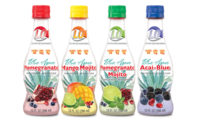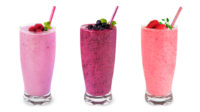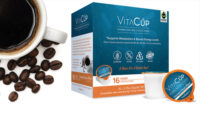Researchers at the Johns Hopkins Bloomberg School of Public Health discovered that many consumers incorrectly estimate the number of calories in foods and drinks, but when the caloric information is provided in a clear, easy-to-understand format, they make different purchasing choices. The study examined the effect of providing clear and visible caloric information about sugar-sweetened beverages at neighborhood stores. It found that providing easily understandable caloric information, specifically in the form of a physical activity equivalent, can reduce the purchase of sugar-sweetened beverages among adolescents by as much as 50 percent.
In one example, consumers were informed that it would take about 50 minutes of running to work off the calories contained in one bottle of soda or fruit juice. As a result, they were 50 percent less likely to purchase the beverage. Other consumers were informed that a bottle of soda or fruit juice contains about 250 calories, which is about 10 percent of a person’s total recommended daily intake of calories. These consumers were 40 percent less likely to purchase a bottle of soda or fruit juice compared to those who did not receive any information.
Researchers conducted the study at four corner stores located in low-income, predominantly African-American neighborhoods in Baltimore. Three caloric information signs were randomly posted throughout the stores, noting sugar-sweetened beverages’ caloric content, recommended caloric intake and physical activity equivalent. Researchers collected data for 1,600 beverage sales to adolescents, aged 12 to 18 years, including 400 during a baseline period and 400 for each of the three caloric-condition interventions.
“People generally underestimate the number of calories in the foods and beverages they consume,” said Sara Bleich, assistant professor with the Bloomberg School’s Department of Health Policy and Management, in a statement. “Providing easily understandable caloric information — particularly in the form of a physical activity equivalent, such as running — may reduce calorie intake from sugar-sweetened beverages and increase water consumption among low-income black adolescents.”
Similarly, a study by HealthFocus International, St. Petersburg, Fla., found that purchases of better-for-you as well as indulgent foods and beverages could be affected by front-of-pack nutritional information. It also discovered that nearly half of U.S. shoppers would like to see calories, saturated fat, trans fat and sodium labeled prominently on food and beverage packages. Most of the shoppers surveyed were seeking low-calorie options, but others were looking for wellness claims or not looking at the label at all, HealthFocus notes. Nevertheless, 60 percent of U.S. shoppers think that front-of-pack labeling would help them to eat and drink more healthily.
Different strokes…
According to HealthFocus International, there are six types of consumers — Disciples, Healers, Strugglers, Investors, Managers and Unmotivated — each of which has a different view when it comes to health and wellness.
Disciples are early adopters of healthy lifestyles, says Barbara Katz, president of HealthFocus. They’re very strict in terms of what they’re consuming, and they’re also well educated, she adds.
“It’s not a very big segment, but it’s a very important segment if you’re looking at launching something that you believe is truly a health and wellness brand,” Katz says.
Healers also are very health-focused, but they see products through a different lens, Katz explains. Typically made up of an older demographic, this segment generally seeks products with a health benefit, such as heart, joint or cognitive health, with less concern about calories.
The baby boomer generation is one of the largest consumer populations in the United States, and many will approach age 65 between 2010 and 2015, Euromonitor International, Chicago, reported in its U.S. health and wellness report. As the generation ages, Euromonitor expects beverage-makers to focus on products that address baby boomers’ health and wellness concerns.
Although HealthFocus’ Healers segment typically consists of older consumers, younger consumers also have an interest in functional wellness products. According to the Natural Marketing Institute, Harleysville, Pa., generation X (between 36 and 47 years of age) and generation Y (between 12 and 35 years of age) have the highest stress levels of any age group and are suffering the health consequences.
“The desire to prolong health and vitality is high across all generations — not just boomers and matures as many would believe,” said Maryellen Molyneaux, president of the Natural Marketing Institute, in a statement. “In fact, [generation] X is significantly more likely to indicate that looking younger is important to them, providing marketers of appearance-linked products, including personal care and food/beverage, with a viable consumer target.”
Generation X is looking for foods and beverages that boost energy, burn stomach fat and provide stress relief, while baby boomers and older consumers are more concerned with heart health, joint pain and lowering cholesterol, the Natural Marketing Institute adds.
Another one of HealthFocus’ consumer segments, Strugglers are calorie- and weight-conscious, but they “struggle” with making healthy food and beverage purchases, HealthFocus’ Katz says.
A mainstream segment, Investors tend to be higher-end consumers interested in the latest trends, she says.
“They like interesting ingredients; they like the new, latest fruit that somebody found from somewhere else; they kind of like to be at the top of the curve from that perspective,” Katz explains. “They’re kind of foodies who are interested in new and different things, and they probably have a little more disposable income in general.”
HealthFocus’ Managers consumer group is more likely to have children. As a result, they’re known for juggling, or managing, a lot of different priorities, she says.
The last group is called Unmotivated. This group is very small and doesn’t typically take health and wellness into account when making food and beverage purchases, Katz says. Their main considerations are taste and what they want at the moment. Obese consumers might fit into this group because of their lack of interest in their diets. According to the HealthFocus study, obese shoppers have less of an interest in front-of-pack labeling than other shoppers. In fact, they read labels less often and pay less attention to their diets than shoppers of normal weight, the study states.
In addition to consumer segmentation, natural and organic foods and beverages could throw a wrench into consumer preferences. Organic shoppers might ignore calorie or fat content in order to purchase an organic-certified product. Natural products, however, are more mainstream, which means that consumers might still take calories and other nutritional values into consideration when buying a natural product, Katz notes.
Trimming the fat
In 2010, more than 80 percent of Americans were overweight or obese, according to Euromonitor International’s U.S. health and wellness report. That statistic is expected to increase in the coming years; however, individuals and organizations are trying to reverse it.
First Lady Michelle Obama, for instance, is pushing for federal legislation to reduce the incidence of childhood obesity. Her Let’s Move! initiative aims to inform parents about healthier lifestyles for their children. In support of her campaign, non-alcohol beverage-makers including The Coca-Cola Co., PepsiCo, Dr Pepper Snapple Group, Nestlé Waters North America, Honest Tea, Sunny Delight Beverages and Cott Beverages volunteered to take part in the American Beverage Association’s (ABA) Clear on Calories initiative, which asks companies to prominently label the number of calories in their products on the packaging.
According to the agreement, beverages as large as 20 ounces feature a product label on the front of the package that displays the total calorie count. Containers larger than 20 ounces are labeled for each 12-ounce serving for all non-alcohol beverages except 100 percent juices and juice drinks, which are labeled for each 8-ounce serving. The labels were designed with a uniform appearance and are placed on beverage packages in a consistent location.
Vending machines operated by beverage-makers showcase calorie counts on selection buttons or close to the selection button, and company-controlled fountain equipment displays calorie counts prominently. The Clear on Calories initiative kicked off in 2010 and will be completed this year, according to the ABA.
“With our Clear on Calories initiative, the beverage industry is already providing calorie information at the fingertips of consumers,” according to an ABA statement. “We agree that consumers should be armed with information about the calories contained in the foods and beverages they choose. By placing new calorie labels on the front of every bottle, can and pack we produce, we’re helping consumers — especially parents — choose the beverage that is best for them and their families.”
To demonstrate the beverage industry’s effort toward reducing obesity in America, the ABA points out that its members reduced the total amount of calories in beverages by 21 percent from 1998 to 2008. This decrease is due in part to the emergence of more zero-calorie, low-calorie and smaller-portion beverages, it says.
The association also implemented national School Beverage Guidelines, which removed full-calorie soft drinks from all schools and replaced them with lower-calorie, smaller-portion options. Under the voluntary guidelines, only juice, low-fat milk and water are allowed in elementary and middle schools, with the addition of low-calorie and portion-controlled beverages in high schools. The companies that took part in the guidelines helped to drive an 88 percent reduction in beverage calories shipped to schools since 2004, the ABA says.
ABA members also have committed to global marketing standards that prevent marketing beverages other than fruit juice, milk and water to children younger than 12. In addition, many beverage companies participate in the Children’s Food and Beverage Advertising Initiative, which further limits marketing to children, the ABA says.
What’s to come
In addition to beverages at retail, the foodservice industry will continue to adapt to health and wellness trends this year, according to Chicago-based Mintel Group Ltd. One of the ways it will do so is with double-sided menus. Consumers aren’t so health-oriented that they’re demanding completely healthy menus, but they are looking for healthy choices, the market research firm notes. As a result, many restaurants will feature indulgent options balanced with healthier options on their menus.
Another prediction for the year comes from U.K.-based Leatherhead Food Research, which foresees a decrease in salt, fat and sugar in foods and beverages. To compensate for these lower levels, there will be an increase in demand for more flavorful solutions, such as herbs, spices and other strong flavors, the market research firm says.
In addition, food- and beverage-makers will continue to promote their products’ health benefits and functional attributes with claims such as “one of your five a day” servings of fruit or vegetables.
Longer working lives and an interest in maintaining a healthy lifestyle also have consumers seeking products with glucosamine for joint health or omega-3 fatty acids for brain health, Leatherhead says.
“2012 looks set to be one in which ongoing trends will be stretched to their full potential, particularly as consumer concerns about health and wellness have prevailed and continue to be high on the agenda,” said Laura Kempster, senior market analyst for Leatherhead Food Research, in a statement. “Coupled with this, the uncertain economic future continues to affect both industry and consumers with a ‘tightening-of-belts’ attitude still very much affecting spending and investment.”
The health and wellness segment was flat in 2009, due to either market saturation or the economic downturn, Euromonitor International says. In 2010, however, total health and wellness food and beverage sales rebounded in the United States with single-digit increases.
“It appears with a recovering economy, Americans are yet again receptive to paying more for health foods suggesting room for market growth,” states Euromonitor’s U.S. health and wellness report. “However, future growth is expected to be hampered by greater frugality than was apparent previous to 2009 as consumers are more price sensitive in shopping for healthy options.” BI








